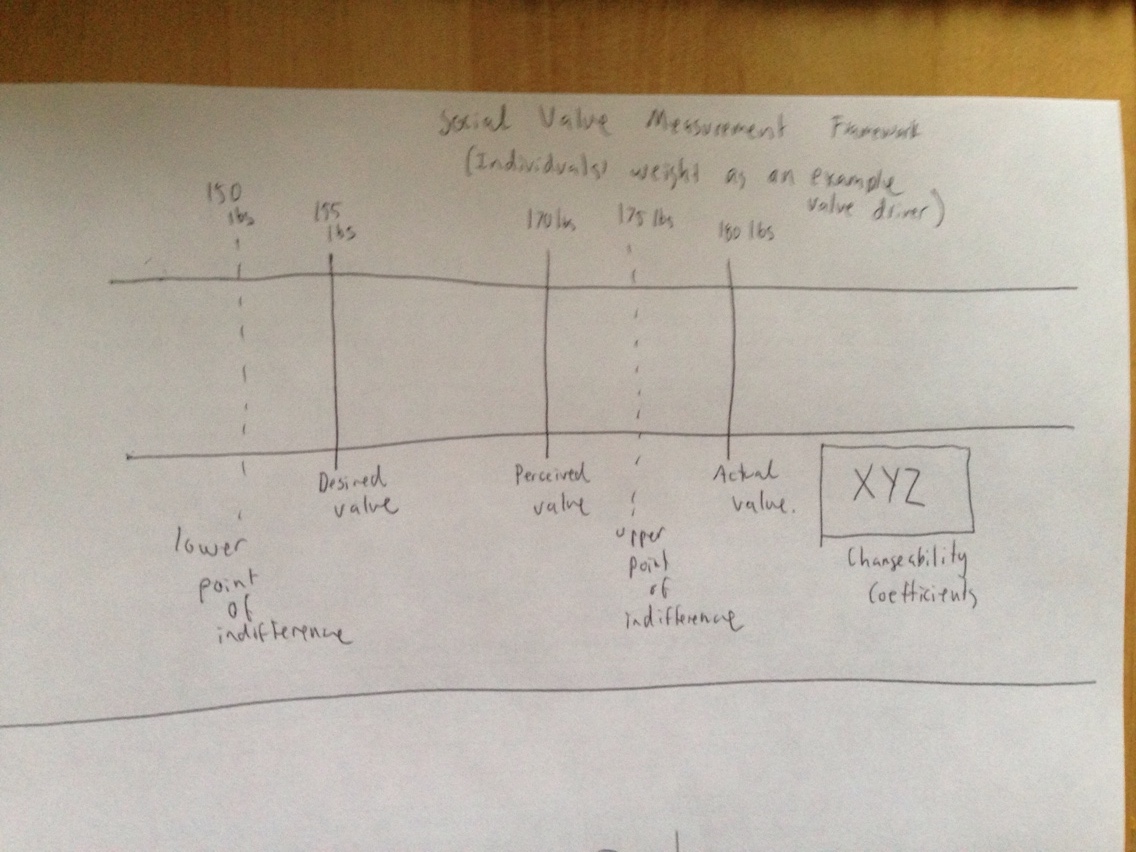In the previous post of this series, I proposed that we don’t have a sound theoretical framework for understanding forms of non-economic value creation. Because we don’t have a theoretical framework for understanding non-economic value (e.g., social value) we don’t have tools to measure and assess our efforts to create it. In turn, we aren’t very good at addressing social problems. As I mentioned in the post, Business Must Do Good, social value is all about happiness. So any framework for understanding social value must aim to explain happiness, which I’ll call “welfare” in this post. For those of you who are economists, you can think of welfare as an analog for consumer and producer surplus.
For now, I’ll go straight into a work-in-progress framework for understanding social value (i.e., welfare), leaving out much of the theoretical underpinnings. I’ll save those for a subsequent post. Needless to say, it’s a little complicated. There are several types of social value (e.g., physical health, intellectual engagement, social engagement, emotional health, etc.). For the sake of introducing the framework, I’ll focus on physical health.
A Framework for Social Value Creation
What’s different about social value, is that it’s not always best to maximizing or minimizing a certain quantity – like some abstract measure of physical health, like resting heart rate or weight. For social value, it’s instead important to be in balance between extremes. Moreover, it’s not always about absolutely quantities either, sometimes welfare is derived from comparisons between an individual’s level of welfare versus another person, versus their aspiration, or versus their perception of their level of welfare.
These observations are the basis of this framework, which is how I propose we conceptualize social value. I will explain each part of it in turn:
Overview: This is a horizontal bar and not a wedge, for a reason. I don’t thin social value should be measured implying more is better than less, it’s all about meeting expectation, being in balance, and having equity between people…because that’s what makes us happy. This bar is a simple way of plotting out certain types of information in a cohesive way, and what is important to interpret is how these quantities of welfare relate to each other.
The bar as a whole is a range of possible levels of welfare for some value driver, in the realm of physical health maybe it’s something like resting heart rate, blood pressure, weight, or some quotient between the three.
Points of indifference: I have plotted upper limits and lower limits of indifference. By this I imply there are values where it doesn’t matter so much if one has more or less welfare. Take resting heart rate or weight for example, if you’re in a certain range you’re considered healthy and it doesn’t really matter if you’re within that range. When you fall outside that range, it’s not a great thing.
For individuals, the interpretation tactic here would be to see whether people fall inside our outside this range of indifference. For societies, you could evaluate – in aggregate – what the distribution of people across the value driver is…say in a histogram. You could also look at whether the range between the indifference points is increasing or decreasing.
Desired Point, Actual Point, and Perceived Point: Think of this using the example of weight. On this horizontal bar, different people would have different desires of where they would want to be, where they actually are, and where they perceive they are. Plotting these points would provide insights on whether people are actually happy because you could evaluate the gaps between these points.
For individuals the interpretation tactic would be to look at the gaps between desired points, actual points, and perceived points because they would give some indication on how happy that person is (because a lot of what makes us happy is whether we are getting what we desire. For societies, you could aggregate and look at centrality and variances measures for these values and the distances between them.
Ability and Perceived Ability to Change Actual Point (Changeability Coefficients): A final component that affects our happiness is whether or not we have the agency to change our actual life outcomes. Again, think of weight as an example – if we think we can’t change our weight or actually can’t change our weight and we want to, it make us unhappy.
You’d have to measure this as some sort of coefficient or rate and represent it in some way (explicitly or maybe changing the color of the graph to represent different coefficients). You could measure this at the individual or aggregate level.
Next Steps
After explaining this framework, I know there are at least two open questions. I will attempt to slowly build on this model by addressing them in future posts. They are:
- “Weight and blood pressure – the examples you gave – are only two of many, many, things that affect happiness and social value…what types of things would you measure?”
- “Let’s say you could determine different types of things to measure. How would you actually collect and analyze the data?”
I also invite you to challenge my ideas a lot. This is a huge idea and I want to work collaboratively to get it right. If we, together, do get this idea right…it sincerely and wholeheartedly believe it could provide the foundation for groundbreaking work.
Once I’m able to articulate the complexities of social value, I’ll move on to Civic Value and Spiritual Value.
If you enjoyed this post, check out my new book which is in pre-sale now. There's also a free PDF version. For more details, visit https://www.neiltambe.com/CharacterByChoice and be sure to let me know what you think after you read it.

